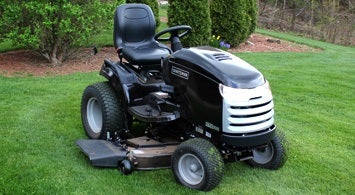
The Craftsman CTX series was first unveiled at the Detroit Auto Show. From a marketing perspective the choice of venue was clever, imaginative and delivered with all the splash Sears could hope for, though in automotive circles the decision created a bit of controversy (more on this later). Tractor.com reviewers were there and in our January preview promised a full review soon as we could get our hands on one.
Our test tractor was made available courtesy of Sears and its marketing folks at Zeno Group and was delivered by YRC Trucking with kid-glove care. The tractor provided was the top-of-the-line model (#25007) with every available option including the largest engine, hydro transmission and deck.
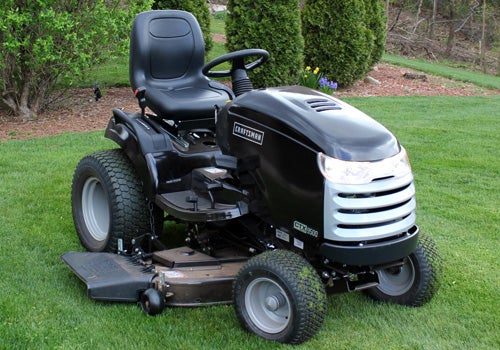 |
But first, the technical niceties. The CTX Series consists of four tractor models ranging from the 20 hp/42” deck CTX 9000 Yard tractor to the tested 30 hp/54” deck CTX 9500 Garden Tractor. The two in-between models are the 22 hp/46” deck CTX 9000 Yard tractor and the 26hp/52” deck CTX 9500 Garden Tractor. Every CTX series tractor begins with a welded 10-gauge frame that is attached to a heavy-duty cast iron axle at the front and a Tuff Torq transmission at the rear. The CTX 9000 20 hp tractor comes with cruise control, the CTX 9000 22 hp gets automatic traction control, the CTX 9500 26 hp adds differential lock, and the CTX 9500 30 hp adds hydraulic attachment lift and power steering. The three tractors below the CTX 9500 we tested (Sears designates them as models 25004, 25005 and 25006) get Tuff Torq K66 transmissions, a heavy duty transmission by any account, but our tractor was equipped with the K71 which puts it in the league with well-known competitors. With those credentials as a foundation, it came as no surprise that the latest Briggs & Stratton Professional Series engines with Electronic Fuel Management (EFM) were the chosen powerplants.
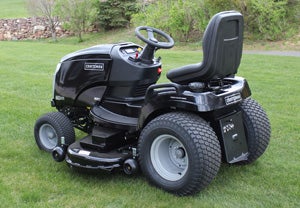
Our test tractor fired right up and immediately impressed with its quiet idle—not at all what you would expect from a big 30 hp V-Twin engine—which we measured at 85.6 dBA from the driver’s seat. A quick adjustment of the 18” high back seat and then the tilt steering (the 13” soft-grip wheel is really nice) and we were off to mow. The cut height is easily dash adjustable and we selected 3-1/2”. Throttling up to 3600 rpms, we measured a sound level of 90.9 dBA which is quite acceptable, though hearing protection is always recommended. But when we engaged the electric Power Take Off (PTO), the noise level shot up to 100 dBA—credit or blame the combination of high lift blades and substantial blade tip speed. Lowering the deck with the automotive turn signal-like control, we started clipping grass. Right away, the cut was level and complete, leaving no windrows between blades, and the discharge finely chopped. Unlike the Simplicity tractors this series is modeled after, the deck hangs from the tractor vs. riding on the ground. Nevertheless, the cut quality was on par with some of the best decks we have tested. Getting to the lower forty where the turf on our test property is a little bumpy, we raised the cut height to 4” which involved no more than a tweak of the dash switch position. Slick. After mowing an acre or so, we stopped to check fluid levels (all were fine) and remarked that the digital gas gauge had barely moved—though later we found the gauge typical of most where the time to drop the first 1/4 seems longer than the last 3/4. No matter, we appreciate the digital instrumentation rather than the sight level or cap gauges some manufacturers are going to.
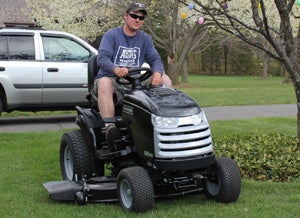
One of our testers commented that though the turning radius was tight (18”) and the effort level with the power steering two-finger easy, the tractor rode rough. A quick check of the tire pressure and we could see why—all four tires were inflated to the max. Taking a few PSI off each fixed that fast.
Taking the CTX 9500 to a section of our test property where a sharp incline can be a challenge, we got a chance to test out the Automatic Traction Control (ATC). The ATC system sends power to both rear wheels so that if one begins to slip the other keeps the tractor going. We found the intervention seamless and most of the time the operator didn’t even realize slippage was taking place. We also found the impact to the turf from ATC engagement non-existent. And though the CTX 9500 is also equipped with differential lock, where both rear wheels can be locked at low speeds, we’re guessing most owners will never need to use this feature—a tribute to the efficiency of the CTX 9500 ATC system.
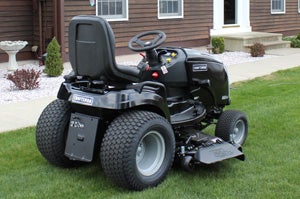
The CTX 9500 rides on 24”x12” rear tires and 16”x6.5” fronts, all of which are Super Turf’s—aggressive enough to keep slippage to a minimum but with minimal damage to your lawn. Universally, the twin-pedal hydrostat control was well-liked and offered infinite control over the 0–8 mph forward and 0-3 mph reverse speed. We might note, all of our testers thought the 8 mph top speed rating was underrated, though we didn’t have the ability to confirm this. No matter, this tractor scoots right along.
Another nice feature of the CTX 9500 is the reverse mowing interlock which Craftsman calls its Reverse Mowing Option (RMO). While some manufacturers have gone to systems—prompted by careless operators and class action hungry lawyers—that require one to press or engage a button each time the machine reverses, Craftsman gives the operator choice of three levels of protection. Level one: yellow plastic key inserted on dash in normal position. Tractor cannot reverse with the PTO engaged or the engine will stall reminding operator to disengage PTO. Level two: remove yellow plastic key from dash and the tractor cannot reverse with the PTO engaged (this position is good for someone borrowing your tractor or perhaps a younger operator). Level 3: twist plastic key to the right while the PTO is engaged and the reverse lock out is overridden (a red LED light signifies RMO is disabled).
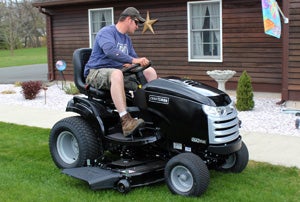
Negatives? Only small nits: one operator thought the engine heat a bit excessive (none of the others thought so); the rough ride (easily fixed by lowering air pressure); noisy mowing sound levels (wear hearing protection); gas cap not labeled (could say GAS or 96 Octane); deck removal, though simple, not quite as easy as some of the competition (in all fairness, the nice height adjustment system requires an electrical cord to be unplugged); a tough location to access the transmission filter (disclosure: the owner’s manual doesn’t even list a service interval and the plate that needs to be removed might even add additional protection to the hydro fan from intrusive twigs and sticks); and lastly, the 54” deck has no washout port (wait: in our eyes that might be a good thing—water+metal=rust).
Positives? The digital instrumentation and general layout of controls; the DC outlet (perhaps to keep those iTunes playing inside those noise cancelling headphones); sturdy steel hood; cruise control; pressurized lubrication for the engine with a spin-on filter; ease of maintenance built in; and, the cockpit ergonomics—our testers ranged from 5’-5” to 6’-4” and all easily found a comfortable position.
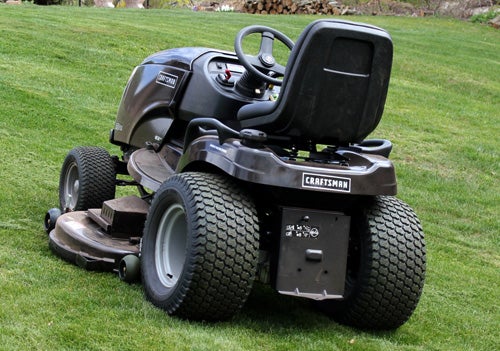 |
The tested CTX 9500 comes with a three-year tractor warranty with an additional two years of coverage on the frame and a limited lifetime warranty on the cast iron front axle. The Sears website lists an MSRP of $7,869, but a 50-state sale price of $6,499.99 is currently on.
So what was the controversy surrounding the Detroit Auto Show? Only that some automotive purists felt slighted by the introduction of something not automotive related at an auto show. We say, get over it. Sears chose to introduce an upscale tractor at an upscale event. We hope the resultant press helps them sell lots of these. If so, there will surely be lots of pleased owners who will be proud to own a heavy-duty machine bearing the Craftsman label. Should you be in the market for a machine of this class, you owe it to yourself to check out the CTX product line.
Related Reading
2012 Craftsman CTX9000 and CTX9500 Preview [Video]
2012 John Deere Select Series X324 AWS Review
2012 Cub Cadet LTX 1046 KW Review
2011 John Deere D170 Review
 Your Privacy Choices
Your Privacy Choices